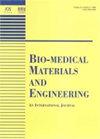Numerical simulation of hemodynamics in patient-specific pulmonary artery stenosis.
IF 1
4区 医学
Q4 ENGINEERING, BIOMEDICAL
引用次数: 0
Abstract
BACKGROUND The incidence rate of pulmonary artery stenosis is increasing year by year and its numerical simulation has become a key project of biomedical engineering. OBJECTIVE The purpose of this work is to study the changes of hemodynamic parameters in patient-specific pulmonary artery stenosis. METHODS A pulmonary artery stenosis model is established based on patient-specific computed tomography (CT) images. According to the actual anatomy of patient-specific pulmonary artery stenosis, the stenosis area is simulated using a porous medium to study its hemodynamic changes. The computational fluid dynamics (CFD) method is used to simulate the hemodynamic changes of pulmonary artery stenosis, and to explore the mechanical characteristics between blood flow and vessel wall. RESULTS The results suggest that the blood pressure of arterial branches increases and the pressure drop at both ends of the stenosis is higher. There is a high flow rate and wall shear stress at the stenosis. CONCLUSION This study shows that the hemodynamic model of pulmonary artery stenosis can be accurately reconstructed by achieving numerical simulation of the local stenosis through CT images, and this work has important implications for improving the confidence of clinical diagnosis and treatment of pulmonary artery diseases.患者特异性肺动脉狭窄血流动力学的数值模拟。
背景:肺动脉狭窄的发病率逐年上升,其数值模拟已成为生物医学工程的重点项目。目的:研究肺动脉狭窄患者血流动力学参数的变化。方法:基于患者特异性计算机断层扫描(CT)图像建立肺动脉狭窄模型。根据患者特异性肺动脉狭窄的实际解剖结构,采用多孔介质模拟狭窄区域,研究其血流动力学变化。采用计算流体动力学(CFD)方法模拟肺动脉狭窄的血流动力学变化,探讨血流与血管壁之间的力学特性。结果:动脉分支血压升高,狭窄两端压降升高。狭窄处存在较大的流速和壁面剪应力。结论:本研究表明,通过CT图像实现局部狭窄的数值模拟,可以准确重建肺动脉狭窄的血流动力学模型,对提高临床肺动脉疾病诊治的信心具有重要意义。
本文章由计算机程序翻译,如有差异,请以英文原文为准。
求助全文
约1分钟内获得全文
求助全文
来源期刊

Bio-medical materials and engineering
工程技术-材料科学:生物材料
CiteScore
1.80
自引率
0.00%
发文量
73
审稿时长
6 months
期刊介绍:
The aim of Bio-Medical Materials and Engineering is to promote the welfare of humans and to help them keep healthy. This international journal is an interdisciplinary journal that publishes original research papers, review articles and brief notes on materials and engineering for biological and medical systems. Articles in this peer-reviewed journal cover a wide range of topics, including, but not limited to: Engineering as applied to improving diagnosis, therapy, and prevention of disease and injury, and better substitutes for damaged or disabled human organs; Studies of biomaterial interactions with the human body, bio-compatibility, interfacial and interaction problems; Biomechanical behavior under biological and/or medical conditions; Mechanical and biological properties of membrane biomaterials; Cellular and tissue engineering, physiological, biophysical, biochemical bioengineering aspects; Implant failure fields and degradation of implants. Biomimetics engineering and materials including system analysis as supporter for aged people and as rehabilitation; Bioengineering and materials technology as applied to the decontamination against environmental problems; Biosensors, bioreactors, bioprocess instrumentation and control system; Application to food engineering; Standardization problems on biomaterials and related products; Assessment of reliability and safety of biomedical materials and man-machine systems; and Product liability of biomaterials and related products.
 求助内容:
求助内容: 应助结果提醒方式:
应助结果提醒方式:


